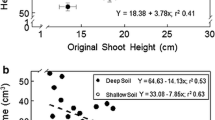Abstract
The heartwood of plantation-grown Cupressus lusitanica, C. macrocarpa, Leyland and Ovens cypress (×Cuprocyparis leylandii and ×C. ovensii) from trials in New Zealand, was evaluated using breast height increment cores and in vitro decay tests with fungal cultures to determine the variation in the heartwood content and natural durability, and its prediction using near-infrared (NIR) spectroscopy. The increment core measurements showed the length of the cores was strongly influenced by the stocking and site, but the heartwood content and weight loss with decay testing were strongly influenced by species and genotype. The heartwood content was consistently high for C. macrocarpa, but varied widely for C. lusitanica, and the Leyland and Ovens cypress clones. The weight loss was similar for the species and cypress clones, with the heartwood classified as very durable and durable, but there were differences in the distributions of less durable heartwood. The NIR calibration models of mass loss with fungal decay testing had ratios of prediction to deviation (RPD) of 1.0–1.3, which suggests the models could be used to segregate the heartwood for high and low values of natural durability.
Zusammenfassung
Kernholz von Cupressus lusitanica, C. macrocarpa sowie Leyland- und Ovens-Zypresse (×Cuprocyparis leylandii und ×C. ovensii) aus Versuchsplantagen in Neuseeland wurde mittels entnommener Bohrkerne in Brusthöhe und In-Vitro-Abbauversuchen mit Pilzkulturen untersucht, um die Variation des Kernholzanteils und der natürlichen Dauerhaftigkeit sowie dessen Vorhersage mittels Nahinfrarotspektroskopie zu bestimmen. Bohrkernmessungen zeigten, dass die Länge der Bohrkerne stark vom Bestockungsgrad und dem Standort beeinflusst wurde. Jedoch hatten die Holzart und der Genotyp einen starken Einfluss auf den Kernholzanteil und den in Abbauversuchen festgestellten Masseverlust. Der Kernholzanteil von C. macrocarpa war durchweg hoch, streute jedoch stark bei C. lusitanica und den Leyland- und Ovens Zypressenklonen. Der Masseverlust war bei den Baumarten und Zypressenklonen vergleichbar zwischen Kernholz, das sehr dauerhaft und dauerhaft klassifiziert wurde. Jedoch wiesen diese unterschiedliche Anteile an weniger dauerhaftem Kernholz auf. Für den Masseverlust bei Pilzabbauversuchen ergaben NIR-Kalibrierungsmodelle ein Vorhersage-Abweichungs-Verhältnis (RPD) von 1,0 bis 1,3. Dies weist daraufhin, dass die Modelle zur Unterscheidung von Kernholz mit hoher oder niedriger natürlicher Dauerhaftigkeit verwendet werden können.



Similar content being viewed by others
References
ASTM D1758-06 (2009) Standard test method of evaluating wood preservatives by field tests with stakes. In: Annual book of ASTM standards, vol. 04.10 Wood. ATSM International, West Conshohocken, PA, pp 220–226
Clark JW (1969) Natural decay resistance of fifteen exotic woods imported for exterior use. Research Paper FPL 103. USDA Forest Service, Forest Products Laboratory, Madison, WI
EN 350-1 (1994) Durability of wood and wood-based products—natural durability of solid wood—part 1: guide to the principles of testing and classification of the natural durability of wood. European Committee for Standardization, Brussels, pp 1–18
EN 113 (1996) Wood preservatives—test method for determining the protective effectiveness against wood destroying basidiomycetes: determination of the toxic values. European Committee for Standardization, Brussels, pp 1–32
Fackler K, Schwanninger M, Gradinger C, Srebotnik E, Hinterstoisser B, Messner K (2007) Fungal decay of spruce and beech wood assessed by near-infrared spectroscopy in combination with uni- and multivariate data analysis. Holzforschung 61(6):680–687
Flæte PO, Haartveit EY (2004) Non-destructive prediction of decay resistance of Pinus sylvestris heartwood by near infrared spectroscopy. Scand J For Res 19(Suppl. 5):55–63
Gierlinger N, Jacques D, Schwanninger M, Wimmer R, Hinterstoisser B, Pâques LE (2003) Rapid prediction of natural durability of larch heartwood using Fourier transform near-infrared spectroscopy. Can J For Res 33(9):1727–1736
Hughes C (1982) The natural durability of untreated timbers. What’s new in forest research, No. 112. New Zealand Forest Research Institute, Rotorua, New Zealand
Leinonen A, Harju AM, Venäläinen M, Saranpää P, Laakso T (2008) FT-NIR spectroscopy in predicting the decay resistance related characteristics of solid Scots pine (Pinus sylvestris L.) heartwood. Holzforschung 62(3):284–288
Littell RC, Milliken GA, Stroup WW, Wolfinger RD (1996) SAS system for mixed models. SAS Institute Inc., Cary
Meder R, Marston D, Ebdon N, Evans R (2010) Spatially-resolved radial scanning of tree increment cores for near infrared prediction of microfibril angle and chemical composition. J Near Infrared Spectrosc 18(6):499–505
NZS 3602 (2003) Part 1: timber and wood-based products for use in building. Standards New Zealand, pp 7–34
Page D (2008) Cypress species, naturally durable alternatives to preservative treated radiata pine timber in buildings. Scion Wood Processing Newsletter, No. 42, pp 1–3
Page D, Foster J, Hedley M (1997) Naturally durable wood—is it a practical alternative to preservative-treated pine? What’s new in forest research, No. 245. New Zealand Forest Research Institute, Rotorua, New Zealand
Sykacek E, Gierlinger N, Wimmer R, Schwanninger M (2006) Prediction of natural durability of commercial available European and Siberian larch by near-infrared spectroscopy. Holzforschung 60(6):643–647
Taylor AM, Freitag C, Cadot E, Morrell JJ (2008) Potential of near infrared spectroscopy to assess hot-water-soluble extractive content and decay resistance of a tropical hardwood. Holz Roh-Werkst 66(2):107–111
Acknowledgments
We thank Dave Henley, Marika Fritzsche, Kane Fleet, and Toby Stovold for the increment core sampling, and Pan Pac Forest Products Limited and Rayonier NZ Limited for allowing access to Gwavas Forest, Hawke’s Bay, and Strathallan Forest, Southland. The research was funded by the MAF Sustainable Farming Fund—Grant No. L08/064, and Future Forests Research Ltd, through the Foundation for Research, Science and Technology—Contract No. C04X0805.
Author information
Authors and Affiliations
Corresponding author
Rights and permissions
About this article
Cite this article
Jones, T.G., Low, C.B., Meder, R. et al. Heartwood of Cupressus lusitanica, C. macrocarpa, Leyland and Ovens cypress and prediction of its durability using near-infrared spectroscopy. Eur. J. Wood Prod. 71, 183–192 (2013). https://doi.org/10.1007/s00107-013-0663-x
Received:
Published:
Issue Date:
DOI: https://doi.org/10.1007/s00107-013-0663-x




